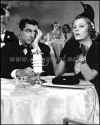Thin-Slicing The Awful Truth

Thin-Slicing The Awful Truth
When I was writing about Renoir’s Rules of the Game the other day, I mentioned Cary Grant and Irene Dunne, probably partly because I knew I had their inspired screwball comedy, The Awful Truth (wonderfully directed by Leo McCarey), waiting in my Netflix queue. Anyway, my wife Suzanne and I watched this movie again last night, and I found myself marveling all over again at how good it is, really one of the best screwballs of all time, with both Grant and Dunne in absolute top form. One of the pleasurable things about watching a really good movie that you’ve already seen a bunch of times before is that you have the luxury of savoring the minute details. Once the romantic complications and plot twists and dramatic turns are no longer a surprise, all the sly textural elements and cinematic subtleties can come to the fore. In this case, I found myself focusing on the gloriously refined comedic play between the two leads—the sort of stuff that looks perfectly natural and unstudied but that takes years of schooling and practice to get that way (with the schooling going all the way back to an acrobatic act in vaudeville in Grant’s case). Again and again, my eye was drawn to the quicksilver play of fluctuating facial expression, as one character reacts to the hijinks of the other. The movie is full of reversals, as first one character and then the other gets the upper hand. The guy or gal in the catbird’s seat gets to gloat, the other one is made to squirm, and the wild shifts from squirm to gloat and back again make for a crazy ride. As a director, McCarey is a great practitioner of the “slow burn,” which the critic David Thomson defines as “the deliciously delayed reacton to disaster on the part of the clown.” Here Cary Grant does a kind of reverse slow burn of delectation as he gradually realizes (and he had just been suffering a minute ago) the humiliation Irene Dunne is about to undergo on the dance floor in the company of her new beau from Oklahoma (a very funnily galumphing Ralph Bellamy). After his first dawning awareness sinks in, Grant pulls up a chair closer to the dance floor to watch the spectacle like a member of the audience. And after slipping a tip to the orchestra leader so he’ll play the same number again--thus ensuring a repeat performance--Grant lets out a sigh of perfect contentment that is the exact inversion of the expression of pained disbelief on Dunne’s face as she heads miserably back to dance floor for further torment.
Watching those facial expressions, I thought of Malcolm Gladwell’s sometimes glib but quite fascinating book, Blink: The Power of Thinking without Thinking, where he talks about our ability, at least at times, to “thin-slice” people and situations, i.e., to make fairly sophisticated and accurate judgments based on very little information (this is not the same as, say, stereotyping, when we use very little information to make bad judgments). One of the book’s strengths is the way it draws on a great range of human experience (art forgery, criminology, tennis, acting, birding, advertising, medical malpractice suits, marriage counseling, and so on), and in one of the its most interesting sections Gladwell talks to a couple of psychologists who have learned to read the often fleeting or covert visible signs of emotion by making use of an elaborate taxonomy of human facial expressions (they have come up with about three thousand meaningful variants).
So would it be possible to construct something like a taxonomy of comedic facial expressions that would explain what makes Grant and Dunne so damn funny in The Awful Truth? I guess this could sound like a reductio ad absurdum of the act of “criticism,” fit only for pedants of the worst sort, but I can imagine the great film critic James Agee taking on a task like that and bringing it exuberantly to life (in fact, it would seem almost like a natural extension of his classic, brilliant essay on “The Golden Age of Film Comedy”). But then again, one could also just forget all about why and go laugh at the movie one more time.

0 Comments:
Post a Comment
<< Home